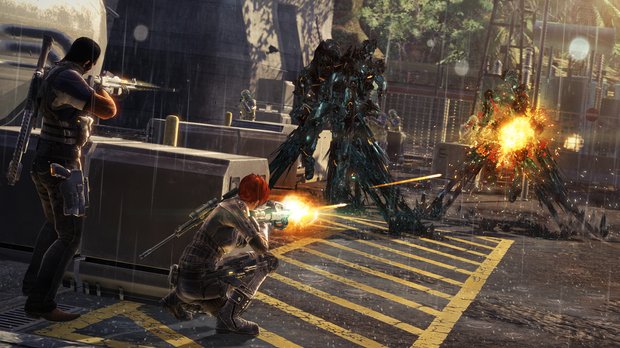Fuse preview - Big weapons, big explosions, big co-op
The name change isn't the only thing that's different about this game
The game formerly known as Overstrike has a new lease on life. With Fuse, Insomniac Games looks to put the studio's gun-centric spin on the mature four-player co-op shooter. We visited Insomniac's headquarters in Southern California last week for a brief hands-on demo with the diverse skill sets of Fuse's quartet of mercenaries.

Why Fuse?
Insomniac Games CEO Ted Price explained the ins and outs of the game during a 30 minute presentation. The studio's aim is to create a story-driven game with "deep co-op." "Why Fuse? It drives our story and gameplay," he said. Fuse is an alien substance discovered in a meteor crash in the 1940s in America. It's highly unstable, and in a contained state, it looks like continuously smoldering ash that floats around. It's highly destructive and nearly always fatal in its pure form. Fuse melds with earthly elements to create something new.
It's that fusion that comes into play as four-person mercenary team Overstrike Nine breaks into a government laboratory to stop rogue organization Raven from stealing a massive cache of the substance. For other reasons to be discovered in-game, each team member picks up a Fuse-enhanced weapon and is bound to it. It also, according to Price, kicks off an arms race that Raven wants to win at all costs.

Dalton Brooks, the leader, picks up the Magshield. It's a hybrid of Fuse and Ferrofluid, a military grade liquid metal that can be manipulated into weaponry or shielding using magnets. Not only does it shield teammates from enemy fire, it collects those bullets and uses the kinetic build-up to thrust those shots back at enemies.
Naya Deveraux acquires the Warp Rifle, which uses Fuse and antimatter to create singularities that literally suck enemies into a black hole, plus she has a cloaking device that lets her sneak around the battlefield. Jacob Kimble's Arc Shot weds Fuse to liquid mercury, resulting in shots that melt foes. With Isabelle "Izzy" Sinclair's Shattergun, you can crystallize anyone who gets in your way and smash them into pieces. Alternately, Izzy's secondary fire shoots a healing crystal out that aids any teammates within a certain radius.

One of Fuse's unique combat hooks lies in how it encourages you and teammates to stack skills on top of one another for experience points, or Fuse points. For example, when Dalton sets up cover, any kills that come via shots through the Magshield get assist points for the assassin and Dalton. That means that, for example, that as Izzy, you can crystalize enemies through the shield, then a friend playing as Jacob or Naya can destroy the crystals, resulting in shared points between everyone. From our brief playtime, it seems like a fun and effective method of encouraging teamwork.
Sign up to the GamesRadar+ Newsletter
Weekly digests, tales from the communities you love, and more
With enough built up points, you can unleash Fusion, which maxes out the Fuse capabilities of each player's weapons, as well as (conveniently) reviving any downed teammates. The game will also feature Leap, which lets you take over any AI-controlled teammates. It's convenient for navigating certain areas in which one character wouldn't be able to manage, like, say, if Dalton is too encumbered in enemies, but Jacob has a vantage point to pick them off, or Izzy can flank and crystallize a swath of them.

With that introduction out of the way, we jumped into four brief rounds of the same section with each Overstrike member. The specialties of each character may remind some of Borderlands, but the weapons and abilities have a strongly tacticle feel, and the third person perspective and heavy emphasis on cover give it something a little different.
One element that we found intriguing was Dalton's Magshield. It's not just a weapon or an XP multiplier, it also functions as mobile cover. As a secondary attack, he can plant the shield in the ground and allow others to duck in and out to pick off enemies. It seems like a feature that will become invaluable in areas where hordes of Raven agents flood and flank the team. Naya's area-of-effect attack, which lets her tag one enemy with multiple wormholes, then tag nearby combatants with just one or two, to eradicate them all, looks really effective as well.

In this section of the game, the group is invading a jungle base--Fuse will take them all over the world, from Indian palaces to Alpine evil lairs--to track down one of Dalton's nemeses. After shooting through waves of enemies, the Overstrike team encountered the Enforcer, a gigantic robot with projectile bolos that can kill teammates if left on too long. It's a fight that's designed to force you to work alongside your teammates as much as possible to distract and defeat it without getting ensnared. Or, in our case, everyone chained together their stored Fusion attacks and downed it in less than two minutes. That's something we hope to see balanced in the final game, as taking down this giant tank proved a bit easy.
We were happy with our initial playtime with Fuse. Although the stage was a bit short, the core mechanics and the ability to share XP spoils feel like great methods to encourage more cooperative play. We adapted rather quickly, as did other teammates, to Insomniac's suggestions to tag team Raven agents for the most points. We'll be very curious to play more stages and get a better feel for the game in the six months leading up to its launch.



